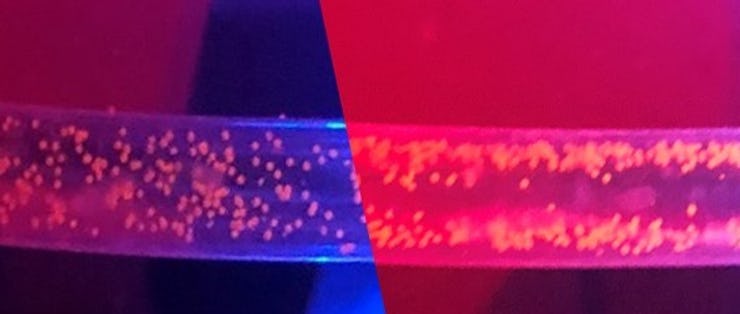This Surprisingly Basic Technology Might Finally Rid Our Drinking Water of Microplastics
The future of water purification sounds great.

Microplastics are everywhere. They’re in our water, our soil, and even in our own bodies, and researchers are still unsure how they are affecting our health. Making things worse, the microscopic waste is also incredibly difficult to get rid of. Recently, though, scientists have come up with a novel solution from a surprising source — sound.
A team of researchers has developed a new method of cleaning microplastics from water using high-pitched sound waves. Unlike previous ultrasound filtering techniques, their method can theoretically remove both large and small microplastic particles using a unique two-step process, effectively making plastic-tainted water safe to drink. The results were presented today at a meeting of the American Chemical Society.
Microplastics are defined as any plastic debris smaller than 5 millimeters across. They usually come from larger pieces of trash, such as water bottles, styrofoam cups, or even acrylic paints, as they break down in the environment. For years, nobody paid much attention to these teeny-tiny pieces of plastic. But in 2004, a landmark study by marine ecologist Richard Thompson documented their presence across 17 different beaches. Since then, they’ve turned up everywhere researchers have looked for them: in soil, in the oceans, and even in our bodies. “[Scientists] have found microplastics in human blood samples,” says Menake Piyasena, an analytical chemist at New Mexico Tech and co-author of the study. “So this is going to be a huge impact in the future.”
Scientists don’t yet have a clear picture of what all that plastic means for human health, but it probably isn’t great. Microplastics have been linked to everything from inflammation to fertility issues to cancer, though the jury is still out on how the tiny polymer shards might cause these conditions. But this means that since 2019, microplastics have been considered an area of concern (and a potential public health emergency) by the World Health Organization.
Right now, most of the microplastics removed from the water are captured using filters. But these devices tend to clog up; they have to be removed, cleaned, or replaced regularly, which can quickly become expensive on a large scale. Piyasena and his lab wanted to come up with a way to remove microplastics that didn’t require a filter. And they found one: ultrasound.
The new water-scrubbing technology relies on a technique Piyasena calls “acoustic focusing.”
“That means using sound waves to focus or concentrate particles in a certain perimeter,” says Piyasena. In this instance, it’s helpful to think of sound not as a soothing piece of music or a conversation but as waves of force pitched in the ultrasonic frequency, above the range of human hearing. When applied inside of a confined area, such as a steel tube, these waves push small particles together — think of the way a speaker might bounce around grains of sand at the beach.
Piyasena’s group isn’t the first to use ultrasound to remove plastic waste from water. Last year, a team of researchers based in Indonesia tested a “sonic scrubber” capable of removing up to 95 percent of small microplastics from freshwater samples (the system proved much less effective in salt water). However, unlike Piyasena’s research, the group only examined plastic fragments smaller than 180 micrometers wide. They assumed that larger fragments would behave in much the same way — but Piyasena and his co-authors found that this wasn’t necessarily true.
“The larger [the plastic] is, the easier it is to focus in some ways,” Piyasena says. When suspended in pure freshwater, every size of microplastic clumped together in the middle of the tube when the researchers turned up the ultrasonic volume, allowing clean water to flow out the side tubes. But when they added detergent or fabric softener to the water, the larger microplastics (between 180 and 300 micrometers across) started to aggregate on the sides of the channel. In this case, water in the center tube was left clean, while the sides were still contaminated with plastic.
To ensure that every size of plastic was removed, the team developed a two-step water cleaning cycle that first gets rid of the super small plastics, followed by the slightly larger ones. In this way, they were able to clear 82 percent of larger particles and more than 70 percent of the smaller ones.
But before they can implement the system in the real world, the researchers will need to do some more experimentation. For example, “we only tested it in one water source,” says Piyasena. But the concentration of salt or other dissolved minerals can affect water’s density, changing the way the microplastics flow through it. If they want to effectively clean all different densities of water, the team will need to be able to predict how the microplastics respond.
This article was originally published on